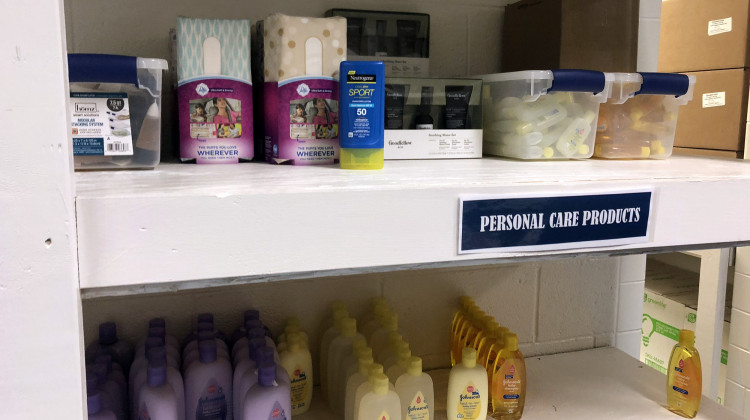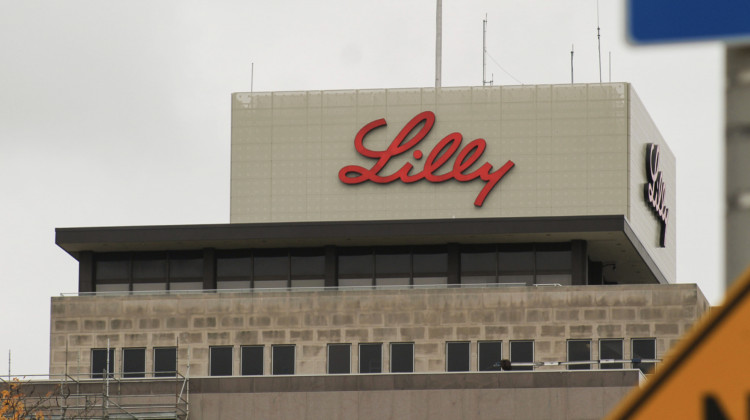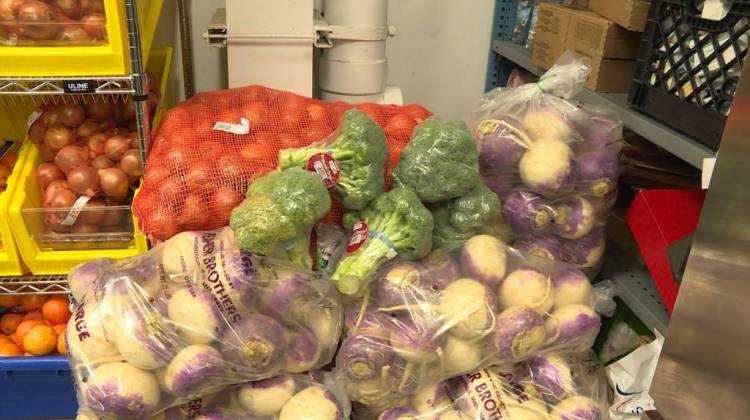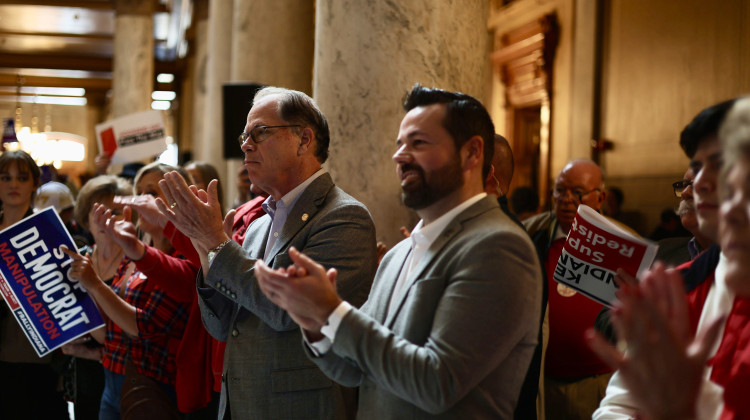
George S. Buck Elementary School in Indianapolis has a food pantry stocked with canned fruits, body wash and soups. Part of Indianapolis Public Schools' approach to mental health includes connecting families to social support.
Carter Barrett/WFYICarter Barrett and Jill Sheridan
After two school shootings last year, lawmakers named mental health services in schools a top priority. Many schools across the state say they need more: more counselors, therapists, funding and support.
State policymakers often point to one school as an example.
Hamilton Southeastern Schools’ established its mental health initiative within a larger, local response to suicide. Indiana youth seriously consider suicide at higher rates than the national average.
In 2015, Fisher’s Mayor Scott Fadness launched a community-wide conversation.
"I could tell you right off top my head that we only had three homicides in 20 years. But in that particular year, 14 people had taken their own life," says Fadness.
The district founded a club to help high school students manage stress. Senior Sam Houston says the club works to reduce the stigma around mental illness.
"Our thought is if we could create an environment, not only in our club meetings but in our school where we accept mental illness and talking about our mental illness becomes normal," says Houston.
In 2016, the affluent suburb north of Indianapolis passed a $17 million referenda. Some of these funds supported a partnership with a mental health care provider. The district also received grant funding for this work.
The partnership means Community Health Network therapists are embedded in nearly every district school. If a parent consents to the treatment, students receive counseling as they would in a doctor's office but they’re in school. Then, the parents’ insurance is billed for the service.
The referenda funds cover additional costs including the coordination of services between therapists and school officials.
Brooke Lawson is the district’s mental health coordinator.
"So it's really nice to have that coordination of service," says Lawson. "The therapist can talk with the teachers, they can talk with the principles, the school counselors, and just really have some open communication about the behaviors that are going on, and also the supports, and the strategies that they're trying to teach the child, they can help reinforce that."
Last year, 600 Hamilton Southeastern students received mental health therapy through this program.
School data shows an increase in GPA and a decrease in discipline problems among students who received treatment. There hasn’t been a youth suicide in the district since 2013.
The Fishers community has seen improved outcomes as well.
Mayor Fadness says the key is combining forces – police, fire department, health care providers and schools – to tackle the issue from all sides.
"We were able to get everybody to the table," says Faddness. "Point everybody in the same direction and then hold each other accountable towards an outcome. That was a challenge in itself."
When asked if this is achievable for other communities?
"People ask that all the time, particularly in the context of Indiana because when I go around, they're like, well, you're Fishers, you have all this money. And in reality, a lot of the things that you can fix don't cost any money," says Fadness.
He acknowledges every community will face different challenges.
"I think everyone in Indiana could do a better job," says Fadness.
Similar programs don’t always have the same outcomes.
During the most recent legislative session, Sen. Michael Crider (R-Greenfield) authored several bills to establish grants to connect more Hoosier students with treatment.
"I feel like it's a bit unfair to expect school counselors to also be mental health providers to understand the mechanisms of mental illness," says Crider.
The bill will help some parents pay for mental health treatment, but it does not give schools money to start mental health programs like Hamilton Southeastern has done.
Crider says another bill that addressed student mental health came with significant pushback.
"It's a subject most people are uncomfortable with, and it's frankly one of those that unless your family's directly impacted, you don't realize how really important this type of bill is," says Crider.
CEO of a mental health consulting group Suzzane Clifford says lawmakers need to do more to help children succeed.
"There's numerous studies demonstrating that if we don't treat mental health conditions, that we have very poor educational outcomes," says Clifford. "It is the largest group of children that are not graduating high school, it is the leading cause of disability of children."
Barriers exist for many school districts. They include lack of leadership, consistent funding and stigma.
Across town, another central Indiana school has implemented mental health services – but still struggles to care for students exposed to poverty, drug addiction and gun violence.
George S. Buck Elementary School, located on Indianapolis’ far east side, has a food pantry stocked with canned fruits, body wash, and soups. In the front office, multiple signs about the importance of regular attendance
Principal Dr. Tenika Holden-Flynn says some students in this zip code have a lot on their mind when they come to school.
"We definitely have students who experienced things at home, right? In terms of domestic violence, abuse, right," says Holden-Flynn. "But even if you are a student who, you know, you don't have that home life, and things are going pretty well, because of the neighborhood, there are things that you're going to be exposed to, you know, murders, robberies."
Like Fishers, this school in Indianapolis Public Schools contracts with a local hospital network.
A therapist at George S. Buck has a caseload of approximately 30 students who receive mental health care at school. Around one-third of these students have previously been in foster care, and nearly all services are billed through Medicaid.
A majority of IPS schools also have a social worker. Yvonne Hollins has worked at George S. Buck for six years – knocking on doors and talking with parents about treatment for their kids.
She says getting families to agree to treatment and reinforcing it can be a challenge, in part, because of stigma.
"I think that so many families feel that because life has happened to them, they are being judged. And they don't want people in their business," says Hollins. "We live in private, but we can't get help in private, we have to be somewhat public. And so yes, I'm a bit relentless.
Hollins says families may struggle with medical bills and lack social support. Some have more basic needs.
"I will deliver food because transportation is a huge issue for a lot of our families, they don't have cars and the bus system. While we sit in a neighborhood, there's not a bus stop right here," says Hollins.
Indianapolis Public Schools did receive grant funding to increase social-emotional learning. Hollins and principal Holden-Flynn say they need more money to offer comprehensive care, in less obvious ways – like reducing class size and teacher assistance.
Brent Freeman oversees mental health in IPS and says they also struggle for community buy-in.
"A big challenge for us would just be getting all of the stakeholders to the table," says Freeman. "And so I know one of the things that we've been looking up at up and Fishers, right, and in Hamilton Southeastern is just their involvement with the mayor's office and EMS, and the police department."
Without strong state and local support, many schools try and cobble together mental health programs, through referenda and grants.
One option that would have created those type of grants fell short in the state legislature. While it does provide a limited pot of money to support individual children. It does not create state funding for districts to set-up, sustain or increase mental health services in schools.
 DONATE
DONATE







 Support WFYI. We can't do it without you.
Support WFYI. We can't do it without you.